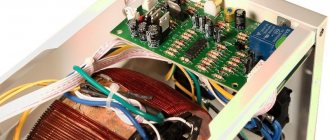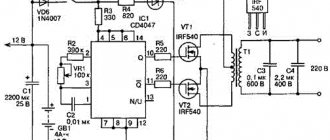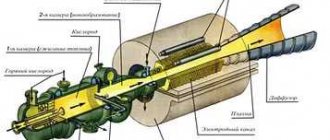Here you will learn:
- Description and principle of operation of a hydrogen generator
- The main advantages of hydrogen heating
- Application area
- Hydrogen generator design
- How to make a generator
- Making a simple hydrogen generator with your own hands step by step
- Heating the house with Brown gas
- Installation safety
- Industrial generator
- Economic expediency
Before making a hydrogen generator, it is necessary to study all the details - economic feasibility, safety. We offer several simple circuits and designs of a hydrogen generator.
General structure of an electrolytic hydrogen generator
Using electrolysis (see the school curriculum for physics and chemistry), water is decomposed into hydrogen and oxygen.
The surface area of the electrodes must be large, so they are collected in packages (cells). By the way, the electrolyzer cannot be overheated above 65 ºС, otherwise the plates will have to be cleaned for a long time or even replaced
There is no need to separate the gases; the combustible mixture is sent to a heat generator, in which a reverse reaction occurs: hydrogen and oxygen reunite, again forming water.
The simplest homemade hydrogen generator is a sealed container with electrodes immersed in liquid, a 12-volt power source.
There is a charge, the water is “gurgling”, Hydrogenium is gone
On the lid of the container there is a fitting for discharging a mixture of hydrogen and oxygen to the consumer (Brown’s gas, “explosive mixture”).
In addition to the fitting, it is advisable to have air vents on the lid
This container is the basis of a hydrogen generator for a car with a carburetor engine. The internal combustion engine runs on a mixture of gasoline and requires an additional storage device and battery. The case is durable, from a water filter, a simple installation created by “people's academicians”, called “AquaCar”, was offered in Ukraine for 1600 hryvnia in pre-revolutionary prices
A hydrogen generator for the home, also in a water filter housing. More efficient cylindrical electrodes are used here, and there is a pressure sensor. Bubbles are visible on the walls of the vessel - the coveted H2 and oxygen
But the point is not just to separate the “rattlers” from the water; it’s no wonder to do this. Gas must be obtained from raw materials in the maximum quantity, in a short time, while spending a minimum of energy. To increase efficiency, they use not ordinary electrodes made of copper or stainless steel, but products of complex shapes made of expensive alloys. The strength of the electric current must change during the reaction, accordingly, an electronic unit is needed.
Version of the electronic unit of the miracle generator
Water is consumed, its level must be constantly maintained, and if this is not done manually, an automatic replenishment system will be needed. Finally, for electrolysis to occur with sufficient intensity, the water must contain a sufficient amount of dissolved salts; in soft water the reaction will be weak, and in distilled water it will be completely absent. This means that you cannot pour water from the tap: you will have to prepare it (the simplest option is a tablespoon of sodium hydroxide per 10 liters of water), which means additional tanks, pipelines, etc.
The figure shows a diagram of a hydrogen generator for a car, but the difference with a device for heating is only that the gas consumer is not the engine nozzles, but the boiler burner
But that's not all. The heat generator (boiler) consumes fuel unevenly, and also requires a certain pressure and humidity. In order for the fuel reactor + heat generator system to work interconnectedly and accurately, hydrogenium must first enter the dryer, then the compressor, which will pump it into the storage facility, where the required pressure must be maintained with the help of additional automation.
DIY electrolyzer for a car
On the Internet you can find many diagrams of HHO systems, which, according to the authors, allow you to save from 30% to 50% of fuel. Such statements are too optimistic and, as a rule, are not supported by any evidence. A simplified diagram of such a system is shown in Figure 11.
In theory, such a device should reduce fuel consumption due to its complete burnout. To do this, Brown's mixture is supplied to the fuel system air filter. This is hydrogen and oxygen obtained from an electrolyzer powered from the car’s internal network, which increases fuel consumption. Vicious circle.
Of course, a PWM current regulator circuit can be used, a more efficient switching power supply can be used, or other tricks can be used to reduce energy consumption. Sometimes on the Internet you come across offers to purchase a low-ampere power supply for an electrolyzer, which is generally nonsense, since the performance of the process directly depends on the current strength.
This is like the Kuznetsov system, the water activator of which is lost, and the patent is missing, etc. In the above videos, where they talk about the undeniable advantages of such systems, there are practically no reasoned arguments. This does not mean that the idea has no right to exist, but the declared savings are “slightly” exaggerated.
Prospects for hydrogen energy
Are there real ways to seriously reduce the cost of pure Hydrogenium? Certainly. This is, first of all, obtaining cheap electricity from renewable sources. Secondly, the use of more advanced chemical catalysts for the process. By the way, they have long been known and are used in automotive hydrogen fuel cells. But again it all comes down to their too high cost.
A really useful application of alternative energy: a serial gas welding device with a built-in hydrogen reactor. In this case, the cost of gas is not decisive; what matters for the welder is that instead of a cylinder and a welder that are inconvenient to transport, he has one relatively small and light box
Science moves forward, technology improves. Someday the oil will run out and humanity will have to switch to other sources of energy. In the meantime, we can say with confidence that hydrogen energy is unprofitable (except for those cases when flammable gas is a by-product of technological processes), and programs for the development of hydrogen transport are possible only thanks to state and corporate programs to support alternative energy.
The municipalities of major German cities are compensating transport companies for all losses so that these beautiful hydrogenium buses transport passengers without polluting the environment
conclusions
Today it is difficult to say which of the promising energy technologies will “shoot” in the future, when hydrocarbon reserves run out. Will it be thermonuclear fusion, solar or gravitational systems, hydrogen energy? So far, the evolutionary development of promising directions is underway and revolutionary breakthroughs are not expected in this area in the near future, no matter what the “yellow” Internet writes about. According to experts, the emergence of hydrogen electrolysis reactors, which could be a real competitor to traditional fuels, is expected no earlier than in 20-30 years. Many experts are generally skeptical about the prospects of hydrogen energy, leaving this type of fuel only a narrow niche in rocket science. But everyone who is involved in this business professionally agrees that truly efficient hydrogen reactors will be a product of high technology, and not “devices” assembled from old pots and other unnecessary pieces of hardware.
(no votes yet)
How does hydrogen heating work?
This heating method was developed by one of the Italian companies. A hydrogen boiler operates without generating any harmful waste, which is why it is considered the most environmentally friendly and silent way to heat a home. The innovation of the development is that scientists managed to achieve the combustion of hydrogen at a relatively low temperature (about 300? C), and this made it possible to produce similar heating boilers from traditional materials.
Hydrogen fuel cells for home
When operating, the boiler emits only harmless steam, and the only thing that requires costs is electricity. And if you combine this with solar panels (solar system), then these costs can be completely reduced to zero.
Note! Hydrogen boilers are often used to heat underfloor heating systems, which can be easily installed with your own hands. How does it all happen? Oxygen reacts with hydrogen and, as we remember from middle school chemistry lessons, forms water molecules
The reaction is provoked by catalysts, as a result, thermal energy is released, heating the water to approximately 40? C - the ideal temperature for “warm floors”
How does it all happen? Oxygen reacts with hydrogen and, as we remember from middle school chemistry lessons, forms water molecules. The reaction is provoked by catalysts, as a result, thermal energy is released, heating the water to approximately 40? C - the ideal temperature for a “warm floor”.
Adjusting the boiler power allows you to achieve a certain temperature required for heating a room of a given area. It is also worth noting that such boilers are considered modular, since they consist of several channels independent of each other. In each of the channels there is the catalyst mentioned above, as a result, the coolant enters the heat exchanger, which has already reached the required value of 40? C.
Note! A feature of such equipment is that each channel is capable of producing a different temperature. Thus, one of them can be routed to the “warm floor”, the second to the adjacent room, the third to the ceiling, etc.
d.
Brief theoretical part
Hydrogen, also known as hydrogen, the first element of the periodic table, is the lightest gaseous substance with high chemical activity. During oxidation (that is, combustion), it releases a huge amount of heat, forming ordinary water. Let us characterize the properties of the element, formatting them in the form of theses:
- The combustion of hydrogen is an environmentally friendly process; no harmful substances are released.
- Due to chemical activity, the gas does not occur in free form on Earth. But its reserves in water are inexhaustible.
- The element is extracted in industrial production by a chemical method, for example, in the process of gasification (pyrolysis) of coal. Often a by-product.
- Another way to produce hydrogen gas is by electrolysis of water in the presence of catalysts - platinum and other expensive alloys.
- A simple mixture of hydrogen + oxygen gases explodes from the slightest spark, instantly releasing a large amount of energy.
For reference. Scientists who first separated the water molecule into hydrogen and oxygen called the mixture an explosive gas due to its tendency to explode. Subsequently, it received the name Brown's gas (after the name of the inventor) and began to be designated by the hypothetical formula NHO.
Previously, airship cylinders were filled with hydrogen, which often exploded.
From the above, the following conclusion suggests itself: 2 hydrogen atoms easily combine with 1 oxygen atom, but part very reluctantly. The chemical oxidation reaction proceeds with the direct release of thermal energy in accordance with the formula:
2H2 + O2 → 2H2O + Q (energy)
Here lies an important point that will be useful to us in further debriefing: hydrogen reacts spontaneously from combustion, and heat is released directly. To split a water molecule, energy will have to be expended:
2H2O → 2H2 + O2 – Q
This is the formula for an electrolytic reaction that characterizes the process of splitting water by supplying electricity. How to implement this in practice and make a hydrogen generator with your own hands, we will consider further.
Is it possible to create a hydrogen generator yourself?
It’s better not to take risks, because such a process is associated not only with the need to know the intricacies of technology and chemistry, but also requires proper compliance with safety rules. But installing the equipment yourself is possible. To do this, it is enough to follow the instructions and avoid amateur activities.
Heating of any home should ensure not only comfortable human living, but also the ecological cleanliness of the environment. This is achieved due to the fact that after the combustion of hydrogen no harmful compounds are formed.
https://youtube.com/watch?v=Hh_a-v081rk
In Western countries, heating using hydrogen generators has gained widespread acceptance and economic justification. If a similar method takes root in Russia, it will significantly increase heating efficiency with minimal resource costs.
Making a generator in-house
On the Internet you can find many instructions on how to make a hydrogen generator. It should be noted that it is quite possible to assemble such an installation for your home yourself - the design is quite simple.
DIY hydrogen generator components for heating in a private home
But what will you do with the resulting hydrogen? Once again, pay attention to the combustion temperature of this fuel in the air. It is 2800-3000°C
If you consider that metals and other solid materials are cut with the help of burning hydrogen, it becomes clear that installing the burner in a regular gas, liquid fuel or solid fuel boiler with a water jacket will not work - it will simply burn out.
Craftsmen on the forums advise lining the inside of the firebox with fireclay bricks. But the melting point of even the best materials of this type does not exceed 1600°C; such a firebox will not last long. The second option is to use a special burner that can reduce the flame temperature to acceptable values. Thus, until you find such a burner, you should not start installing a homemade hydrogen generator.
Tips for assembling and operating a generator
Having solved the issue with the boiler, choose a suitable diagram and instructions on how to make a hydrogen generator for heating a private house.
A homemade device will be effective only if
:
- sufficient surface area of the plate electrodes;
- correct choice of material for the manufacture of electrodes;
- high quality liquid for electrolysis.
What size should be the unit that generates hydrogen in sufficient quantities to heat a house will have to be determined “by eye” (based on other people’s experience), or by first assembling a small installation. The second option is more practical - it will allow you to understand whether it is worth spending money and time on installing a full-fledged generator.
Rare metals are ideally used as electrodes, but this is too expensive for a home unit. It is recommended to choose stainless steel plates, preferably ferromagnetic.
Hydrogen generator design
There are certain requirements for water quality. It should not contain mechanical impurities and heavy metals. The generator operates most efficiently on distilled water, but to reduce the cost of design, you can limit yourself to filters to purify water from unnecessary impurities. To make the electrical reaction more intense, sodium hydroxide is added to the water in a ratio of 1 tablespoon per 10 liters of water.
Selected points of use
First of all, I would like to note that the traditional method of burning natural gas or propane is not suitable in our case, since the combustion temperature of HHO is more than three times higher than that of hydrocarbons. As you yourself understand, structural steel will not withstand this temperature for long. Stanley Meyer himself recommended using a burner of an unusual design, the diagram of which is given below.
Scheme of a hydrogen burner designed by S. Meyer
The whole trick of this device is that HHO (indicated by the number 72 in the diagram) passes into the combustion chamber through valve 35. The burning hydrogen mixture rises through channel 63 and simultaneously carries out the ejection process, entraining outside air through adjustable openings 13 and 70. Under the hood 40, a certain amount of combustion products (water vapor) is retained, which enters the combustion column through channel 45 and mixes with the burning gas. This allows you to reduce the combustion temperature several times.
The second point that I would like to draw your attention to is the liquid that should be poured into the installation. It is best to use prepared water that does not contain heavy metal salts. The ideal option is distillate, which can be purchased at any auto store or pharmacy. For successful operation of the electrolyzer, potassium hydroxide KOH is added to the water, at the rate of approximately one tablespoon of powder per bucket of water.
During operation of the installation, it is important not to overheat the generator. When the temperature rises to 65 degrees Celsius or more, the electrodes of the device will become contaminated with reaction byproducts, which will reduce the productivity of the electrolyzer. If this does happen, then the hydrogen cell will have to be disassembled and the deposits removed using sandpaper.
And the third thing we place special emphasis on is safety. Remember that it was not by chance that the mixture of hydrogen and oxygen was called explosive. HHO is a hazardous chemical that can cause an explosion if not handled properly. Follow safety rules and be especially careful when experimenting with hydrogen. Only in this case, the “brick” that our Universe consists of will bring warmth and comfort to your home.
We hope you found this article a source of inspiration and will roll up your sleeves and start making a hydrogen fuel cell. Of course, all our calculations are not the ultimate truth, however, they can be used to create a working model of a hydrogen generator. If you want to completely switch to this type of heating, then the issue will have to be studied in more detail. Perhaps your installation will become the cornerstone, thanks to which the redistribution of energy markets will end, and cheap and environmentally friendly heat will enter every home.
What is hydrogen
Hydrogen is the most abundant chemical substance on our planet. A colorless gas that contains no toxins, it is present in almost all compounds. The substance is endowed with unique properties. In solid and liquid states, hydrogen has virtually no mass. The size of its atoms is the smallest in comparison with other chemical elements.
The substance obtained by mixing hydrogen with the surrounding air can retain its properties for a very long time while indoors, but can explode from minimal contact with fire. For transportation and storage, special cylinders made of alloy steel are used.
Hydrogen generator design
To build hydrogen generators with your own hands, they usually take Brown’s classic installation scheme as a basis. This medium-power electrolyser consists of a group of cells, each of which contains a group of plate electrodes. The power of the installation is determined by the total surface area of the plate electrodes.
The cells are placed inside a container well isolated from the external environment. The tank body has pipes for connecting the water main, hydrogen outlet, as well as a contact panel for connecting electricity.
Hydrogen generation apparatus designed according to Brown's scheme. By all calculations, this installation should fully provide the household with heat and light. Another question is what dimensions and power will allow this to be done (+)
Economic question
Before you begin to understand in detail how to make a hydrogen generator, it is advisable to remember your school physics course. All transformations occur with a loss of energy, that is, the cost of electricity to produce hydrogen will not be recouped by the thermal power when burning the resulting fuel.
If we consider that it is simply impossible to burn hydrogen at maximum temperature and heat transfer at home, it becomes clear that real losses will be even higher than those calculated for ideal conditions.
So, using a DIY hydrogen generator for heating doesn't make any sense if you don't have access to free electricity. Installing an electric boiler to heat your home and spending electricity directly, without complex transformations, will cost you 2-3 times less. In addition, the electric boiler is completely safe, and the operation of a homemade installation can lead to an explosion if the installation and operation rules are not followed.
Obviously, producing cheap hydrogen in an environmentally friendly way, which includes electrolysis, is a matter of the future, which scientists in the leading countries of the world are working on today.
Law of conservation of energy ↑
Everything in nature is interconnected. If something has arrived somewhere, it means it has left somewhere. This folk wisdom simplifies, but generally correctly describes the law of conservation of energy. Hydrogen, when burned, releases thermal energy. But to produce gas by electrolysis, you will have to spend a certain amount of electricity. Which, in turn, is largely obtained through the generation of heat when burning other types of fuel. And if we take the clean thermal energy necessary to generate electricity and the energy that hydrogen will provide during combustion, even the most advanced installations result in double losses. We literally throw away half the money. And these are only operating costs, but you should also take into account the cost of very expensive equipment.
AeromodellerII wind-hydrogen airship project. Belgian engineers painted a beautiful picture, all that remains is to back it up with specific economically feasible technologies
According to the INEEL research laboratory, in US industrial hydrogen generators the cost of one kilogram of hydrogen was:
- Electrolysis from an industrial power supply - 6.5 usd.
- Electrolysis from wind generators - 9 usd.
- Photoelectrolysis from solar devices - 20 usd.
- Production from biomass - 5.5 usd.
- Conversion of natural gas and coal - 2.5 usd.
- High-temperature electrolysis at nuclear power plants - 2.3 usd. This is the least expensive method and the furthest away from home conditions.
Moreover, even the best hydrogen generator at home will be noticeably inferior in efficiency to an industrial one. With such prices, there is no reason to talk about any serious competition for hydrogen fuel compared not only with cheap natural gas, but also with expensive electric heating, diesel fuel and even heat pumps.
Main nuances of hydrogen boilers
The power of hydrogen-based boilers is selected depending on the area of the structure that needs to be heated.
Using this type of technology, you can solve many heating-related problems. This occurs due to the simultaneous functioning of several channels designed to generate hydrogen energy (there can be a maximum of 6).
The modular system inherent in hydrogen boilers ensures independent operation of the channels, without in any way affecting the efficiency of the installation. Each individual channel contains its own catalyst.
Advantages of hydrogen heating
A hydrogen-powered boiler is in demand for many reasons:
- The inexhaustibility of hydrogen, as well as the ability to obtain it in any quantity.
- Producing hydrogen is considered more economically profitable than the constant extraction of minerals with flammable properties (gas, coal, oil, etc.).
- The heating system operates without emissions harmful to people and the atmosphere, emitting ordinary water vapor.
- No flame required (works on the basis of chemical reactions).
- The boiler has the highest possible efficiency.
- The device operates completely silently.
- There is no need to build and operate a chimney.
- Safety requirements for hydrogen heating are lower than for gas-based installations.
Disadvantages of hydrogen boilers
Despite the many advantages, it is important to know about the disadvantages of such units:
- the need to constantly replenish the catalyst;
- explosion hazard of the element if strict requirements are not met;
- inconvenient transportation of hydrogen;
- lack of specialists in installation and maintenance of such equipment in Russia;
- insufficient number of necessary spare parts due to the underdeveloped market for hydrogen heating.
The best concentrator models according to Tehno.guru editors
After reading many reviews on the Internet and considering the technical characteristics of many models, the Tehno.guru editorial team selected several of the best models. This should help our dear reader make the right choice without unnecessary hassle and hours of scouring the Internet in search of a good device.
"ARMED 7F-3L" - an oxygen concentrator with good functionality
This is what one of the best devices looks like - “ARMED 7F-3L” “ARMED 7F-3L” is recommended not only for home use, but also for use in kindergarten, school, and fitness center. The productivity of the device is up to 3 l/min at an oxygen concentration of 93%. Device dimensions 480 × 280 × 560 mm, weight – 26.5 kg. Suitable for preparing oxygen cocktails. Here are some of its characteristics.
| brand, model | Oxygen productivity, l/min | Noise level, dB | Power consumption, W |
| ARMED 7F-3L | 0-3 | 49 | 350 |
A little noisy, but overall a pretty decent unit. Here's what netizens say about him.
ARMED 7F-3L
"OXYbar Auto" - a product from the very famous brand "Atmung"
“OXYbar Auto” is one of the quietest and most compact devices. Very quiet, lightweight and compact device
The kit includes an adapter for connecting in a car, which is very important for many on long trips. Weight only 5.2 kg
Today there are no such lightweight devices on the Russian market. The manufacturer claims that the device can operate around the clock. The maximum productivity of the unit is 6 l/min, but the oxygen concentration will be only 30%, which is not encouraging. With a performance setting of 1 l/min, the concentration is acceptable - 90%. Let's look at the characteristics of the device.
| brand, model | Oxygen productivity, l/min | Noise level, dB | Power consumption, W |
| Atmung OXYbar Auto | 0,2-6 | 40 | 115 |
Thus, the device can be called not only the smallest, but also one of the quietest.
Atmung OXYbar Auto
"BITMOS OXY-6000" is a device with fairly good performance
"BITMOS OXY-6000" has good characteristics
| brand, model | Oxygen productivity, l/min | Noise level, dB | Power consumption, W |
| BITMOS OXY-6000 | 1-6 | 35 | 360 |
"BITMOS OXY-6000" is the brainchild of German manufacturers. And, like any German technology, it is made of very high quality. It has a very convenient shape - it is a “suitcase” on wheels, which is very convenient with a weight of 19.8 kg. The dimensions of the device are 520 × 203 × 535 mm. There is a function for preparing oxygen phyto-cocktails. When the temperature rises, the flow rate drops, the oxygen concentration drops, the network turns off and microprocessor errors, the device sounds an audible signal. At a productivity of 1-4 l/min, the oxygen concentration reaches 95%. What about the characteristics?
BITMOS OXY-6000
HELPFUL INFORMATION!
The cost of such devices is quite high and not everyone can afford it. That is why today you can find many companies offering oxygen concentrators for home use for rent at very reasonable prices.
Applications of hydrogen generator
Due to the problems associated with the transportation and storage of hydrogen, such devices are in demand in industries where the presence of this gas is required by the technological cycle. Let's list the main directions:
- Production related to the synthesis of hydrogen chloride.
- Production of fuel for rocket engines.
- Creation of fertilizers.
- Production of hydrogen nitride (ammonia).
- Synthesis of nitric acid.
- In the food industry (for producing solid fats from vegetable oils).
- Metal processing (welding and cutting).
- Metal recovery.
- Synthesis of methyl alcohol
- Production of hydrochloric acid.
The main areas of application of hydrogen generators in industry
Despite the fact that the production of hydrogen during oil refining is cheaper than its production by electrolysis, as mentioned above, difficulties arise with gas transportation. The environmental situation does not always allow the construction of hazardous chemical production facilities directly next to oil refineries. In addition, hydrogen produced by electrolysis is much cleaner than that produced by cracking oil. In this regard, industrial hydrogen generators are always in high demand.
Brown's Gas
Today, hydrogen generators are gaining popularity among car enthusiasts.
However, this is not exactly what was discussed above. By electrolysis, water is converted into the so-called Brown's gas, which is added to the fuel mixture. The main task that this gas solves is complete combustion of the fuel. This serves to increase power and reduce fuel consumption by a decent percentage. Some mechanics have achieved savings of 40%. The surface area of the electrodes is of decisive importance in the quantitative gas yield. Under the influence of an electric current, a water molecule begins to decompose into two hydrogen atoms and one oxygen. When burned, such a gas mixture releases almost 4 times more energy than the combustion of molecular hydrogen. Therefore, the use of this gas in internal combustion engines leads to more efficient combustion of the fuel mixture, reduces the amount of harmful emissions into the atmosphere, increases power and reduces the amount of fuel consumed.
Design features and design of the hydrogen generator
While there are practically no problems with producing hydrogen now, its transportation and storage still remains an urgent task. The molecules of this substance are so small that they can even penetrate metal, which poses a certain safety risk. Absorbed storage is not yet highly profitable. Therefore, the best option is to generate hydrogen immediately before its use in the production cycle.
For this purpose, industrial plants for generating hydrogen are manufactured. As a rule, these are membrane-type electrolyzers. The simplified design of such a device and the principle of operation are given below.
Simplified diagram of a membrane-type hydrogen generator
Designations:
- A – tube for removing chlorine (Cl2).
- B – hydrogen (H2) removal.
- C is the anode on which the following reaction occurs: 2CL—→CL2 + 2е—.
- D is the cathode, the reaction on it can be described by the following equation: 2H2O + 2e— →H2 + OH—.
- E – solution of water and sodium chloride (H2O & NaCl).
- F – membrane;
- G – saturated solution of sodium chloride and the formation of caustic soda (NaOH).
- H – removal of brine and diluted caustic soda.
- I – input of saturated brine.
- J – cover.
Design of a hydrogen cell for a household electrolyzer
Designations:
- a – tube for venting Brown’s gas;
- b – water supply inlet manifold;
- c – sealed housing;
- d – block of electrode plates (anodes and cathodes), with insulators installed between them;
- e – water;
- f – water level sensor (connected to the control unit);
- g – water separation filter;
- h – power supply supplied to the electrodes;
- i – pressure sensor (sends a signal to the control unit when the threshold level is reached);
- j – safety valve;
- k – gas outlet from the safety valve.
A characteristic feature of such devices is the use of electrode blocks, since separation of hydrogen and oxygen is not required. This allows the generators to be quite compact.
Electrode blocks for a plant that produces Brown's gas
Be careful
The gas produced is an explosive mixture of hydrogen and oxygen, so it must be used with extreme caution. The container contains a lot of gas, there is a possibility of it catching fire, and if there is excess pressure, it can even cause an explosion. To avoid detonation of the gas inside the hydrogen generator, the pipes from the container must be connected to another container half filled with water. If there is a fire at the outlet, the flame does not penetrate back into the device. This safety device is absolutely necessary and must be installed.
Household use
There are also uses for hydrogen in everyday life. First of all, these are autonomous heating systems. But here are some peculiarities. Pure hydrogen production plants are much more expensive than Brown gas generators; the latter can even be assembled yourself. But when organizing home heating, it is necessary to take into account that the combustion temperature of Brown gas is much higher than that of methane, so you will need a special boiler, which is somewhat more expensive than a regular one.
The fuel boiler must have the appropriate label
On the Internet you can find many articles in which it is written that ordinary boilers can be used for detonating gas, but this is strictly forbidden. At best, they will quickly fail, and at worst, they can cause sad or even tragic consequences. Special designs with a more heat-resistant nozzle are available for Brown's mixture.
It should be noted that the profitability of heating systems based on hydrogen generators is highly questionable due to low efficiency. In such systems there are double losses, firstly, during the gas generation process, and secondly, when heating water in the boiler. It is cheaper to immediately heat water in an electric boiler for heating.
An equally controversial implementation for domestic use, in which Brown's gas is used to enrich gasoline in the fuel system of a car engine in order to save money.
Using an NGO generator in a car
Designations:
- a – NHO generator (accepted designation for Brown’s gas);
- b – gas outlet to the drying chamber;
- c – compartment for removing water vapor;
- d – return of condensate to the generator;
- e – supply of dried gas to the air filter of the fuel system;
- f – car engine;
- g – connection to the battery and electric generator.
It should be noted that in some cases such a system even works (if it is assembled correctly). But you won’t find exact parameters, power gain coefficient, or savings percentage. These data are highly blurred and their reliability is questionable. Again, the question is not clear how much the engine life will decrease.
But demand creates supply; on the Internet you can find detailed drawings of such devices and instructions for connecting them. There are also ready-made models made in the Land of the Rising Sun.
Installation safety
Many craftsmen place plates in plastic containers. You shouldn't skimp on this. You need a stainless steel tank. If it is not there, you can use a design with open plates. In the latter case, it is necessary to use a high-quality current and water insulator for reliable operation of the reactor.
It is known that the combustion temperature of hydrogen is 2800. This is the most explosive gas in nature. Brown's gas is nothing more than an “explosive” mixture of hydrogen. Therefore, hydrogen generators in road transport require high-quality assembly of all system components and the presence of sensors to monitor the progress of the process.
A working fluid temperature sensor, pressure sensor and ammeter will not be superfluous in the design of the installation. Particular attention should be paid to the water seal at the outlet of the reactor. It is vital. If the mixture ignites, such a valve will prevent the flame from spreading into the reactor.
A hydrogen generator for heating residential and industrial premises, operating on the same principles, is distinguished by several times greater reactor productivity. In such installations, the absence of a water seal poses a mortal danger. In order to ensure safe and reliable operation of the system, it is also recommended to equip hydrogen generators on cars with such a check valve.
Features of a hydrogen generator
Based on the requirements and size of a private or municipal building, it is necessary to select a hydrogen burner with an optimal power level, adapted to the needs of a particular room. It should be noted that the maximum possible power rating of the generators is 6.
Hydrogen, rightfully recognized as the most economical type of fuel, can be produced in any quantity. A prerequisite for this is the availability of electrical energy and water.
The main task of the equipment is complete independent heating of premises. However, hydrogen-based installations can perfectly complement existing home heating systems. You just need to make sure that all elements of the heating system operate at low temperatures.
These units are also used to heat the room using heated floors, which are now easy to assemble with your own hands.
Operating principle of the device
The heat generation process is based on the electrolysis of water in a medium saturated with a catalyst. The main condition for the normal operation, as well as the safety of the generator, is that under such conditions, water does not decompose into oxygen and hydrogen, the combination of which can be explosive.
Modern generators work to produce Brown gas. This is a completely non-explosive substance of a brownish or green hue, also called water gas. After production and heating to 40 degrees, it immediately goes to the combustion chambers, and more specifically, to the heat exchanger. There it is mixed with air-fuel elements.
Hydrogen Generator Components
The main structural components of the simplest hydrogen unit are pipes and the boiler itself. Often no technical accessories or additional elements and devices are required anymore.
This also applies to components designed to remove combustion products. After all, as a result of the operation of the generator, only steam is released into the atmosphere: water, clean and completely safe.
Often, burners of this type have a modular design, each part of which has its own catalyst, which increases the overall efficiency of the system.
Regarding pipes for a hydrogen heating system. then it is advisable to use those whose diameter is in the range from 1 to 1.25 inches. Some deviations are allowed, but most often these particular ones are used to heat a house.
An important rule that should not be neglected when installing heating pipes is that each previous branch must be larger in diameter than the next one.
Specifications
| Hydrogen purity in terms of dry gas, % vol. | 99,9999 |
| Concentration of water vapor at 20OC and 1 atm, no more, ppm, | 5 |
| Total hydrogen productivity, reduced to normal conditions, not less than, l/h, | 12 |
| Range of specified hydrogen output pressure, atm, | from 3.0 to 6.1 |
| Stability of hydrogen output pressure, no worse than | ±0,02 |
| Time to establish the operating mode, with the output muted, no more than, min, | 30 |
| Volume of distilled water poured, l, | 1,0 |
| Consumption of distilled water, no more than l/hour, | 0,02 |
| Water consumption, g/l hydrogen, | 1,6 |
| Average resource of a replaceable deionization filter cartridge (at maximum productivity and single-shift operation), years, not less than | 1 |
| Average power consumption: | |
| in stationary mode, no more than VA, | 180 |
| maximum (at startup), no more, VA, | 220 |
| Overall dimensions of the generator, (width x depth x height), no more than, mm, | 230x470x450 |
| Generator weight. no more, kg, | 16 |
| Working conditions: | |
| ambient temperature, °C, | from +10 to +35 |
| power supply from a single-phase alternating current network voltage, V, | 220 (+10 –15)% |
| and frequency, Hz, | 50 +1 |
| The generator meets electrical safety requirements | class 1, type N according to GOST 12.2.025-76 |
Additional technical specifications
| Monitoring the quality of water poured into the supply tank | + |
| Built-in water treatment system (control and automatic purification of water supplying the electrolysis module) | + |
| Built-in system for automatic regeneration of hydrogen fine filters | + |
| Controlling the humidity of the hydrogen produced | + |
| Depressurization control | + |
| Possibility to turn on the “BLOW OUT” mode | + |
| Displaying information about operation, individual parameters, faults on the display | + |
A little history
The principle of operation of hydrogen energy was noted in ancient times. The famous healer Paracelsus, while conducting his scientific experiments, noticed that when certain elements were combined, bubbles were formed, which at that time he mistook for air. It was later discovered that it was hydrogen, which is a colorless gas that exhibits explosive properties under certain conditions.
Currently, they have learned to use hydrogen for various purposes, including heating a residential building or any other structure. These technologies are being actively developed and implemented in many industries. As an innovation on the scientific development market, hydrogen heating has already attracted the interest of many consumers and continues to gain popularity among the general public.
It has been proven that hydrogen is considered not only a fairly common substance, but also an easily accessible substance. The only difficulty is that it has to be extracted from chemical compounds, most often water.
No. 8. Dining table style
It’s probably not worth even talking about the fact that the dining table should fit into the interior of the kitchen space. It is advised to choose a table and chairs at the very end of a kitchen renovation, when all the subtleties of the created interior are known. But it’s better to create a project for the future kitchen in advance, and choose the table that will fit in as best as possible. Kitchens made in a classic style will be complemented by wooden dining tables. Modern spaces will look great with a glass table and transparent plastic chairs.
Modern kitchens and studio kitchens today are often equipped with bar counters. They serve both as a space separator for the work area and the dining area, and as an additional surface where you can also have lunch or a snack.
Hydrogen heating: myth or reality
A generator for welding is currently the only practical application of electrolytic water splitting. It is not advisable to use it for heating a house and here's why. Energy costs during gas-flame work are not so important; the main thing is that the welder does not need to carry heavy cylinders and fiddle with hoses. Another thing is home heating, where every penny counts. And here hydrogen loses to all currently existing types of fuel.
Serial welding generators cost a lot of money because they use catalysts for the electrolysis process, which include platinum. You can make a hydrogen generator with your own hands, but its efficiency will be even lower than that of a factory one. You will definitely be able to get flammable gas, but it is unlikely to be enough to heat at least one large room, let alone an entire house. And if there is enough, you will have to pay exorbitant electricity bills.
Rather than wasting time and effort on obtaining free fuel, which does not exist a priori, it is easier to make a simple electrode boiler with your own hands. You can be sure that this way you will spend much less energy with greater benefit. However, DIY enthusiasts can always try their hand at assembling an electrolyzer at home in order to conduct experiments and see for themselves. One such experiment is shown in the video:
Model with two filters
It is quite simple to assemble this type of electrolyzer for a car with your own hands. First of all, you need to prepare four sheets of metal. In this case, galvanized steel can be used. In this case, stainless steel for electrolyzers is also suitable. After this, the container with water is installed directly. Holes can be made in it using a knife
Next, to make an electrolyzer with your own hands, it is important to secure the filters. You can use a regular mesh type. It’s not difficult to buy it in a store.
The next step is to fix the check valve. To do this, the container must be secured to the base. To do this, many experts advise using bolts. Next, all that remains is to install a board with a thickness of no more than 2.3 mm. The next step is to fix the bubble-type tube
It won't be difficult to buy it in a store. The next step is to fix the check valve. To do this, the container must be secured to the base. To do this, many experts advise using bolts. Next, all that remains is to install a board with a thickness of no more than 2.3 mm. The next step is to fix the bubble-type tube
It is important to monitor the water level in the container. The injector is installed last. The shutter in this case should be located on the board side
The terminals are attached only after sticking the gasket
The shutter in this case should be located on the board side. The terminals are attached only after sticking the gasket.
Independent construction
Due to the fact that there is currently no mass production of such units, purchasing them is not an easy process. Most likely, you will have to place an individual order or negotiate the supply of equipment from Italy, where such devices were first developed and put into operation.
But not all consumers can afford such a solution to the problem. In this case, it is worth considering the possibility of building a boiler with your own hands.
How does a homemade hydrogen heating boiler work?
The hydrogen heating system consists of a generator, burner and boiler.
At the moment, no source can provide accurate and success-guaranteing instructions for constructing a hydrogen boiler. But according to the skills and experience of practicing chemists and technicians, such a unit should consist of the following components:
- Heat exchanger.
- Electrolyzer.
- The combustion chamber.
- Safety block protecting against “return” (with 2 stages).
- Container with electrolyte and produced hydrogen. It should be made of alloy or stainless steel, and also be equipped with a valve with which you can relieve pressure in the system.
Operating principle of the boiler
Hydrogen begins to be produced after the electrolytic solution enters the electrolyzer. Under the influence of a catalyst with O2, the element is divided into heat and water. The resulting heat, which has a temperature of about 40 degrees, goes into the heating system, first passing through a heat exchanger. Very often, this temperature is enough to fully heat the house using heated floors.
The water released as a result of the chemical reaction enters the tank (with the electrolyte), and then a certain part of the solution undergoes spontaneous ignition due to the recirculation process.
Ideas for combining flooring in the kitchen
The combination of materials must be thought out before starting work, so that, taking into account the difference in thickness, a difference of the required magnitude can be made on the floor (during its preparation).
Tiles and laminate
These materials are perfectly combined in thickness and physical characteristics. Laminate flooring for the kitchen is selected with the highest degree of strength and moisture resistance. No matter how beautiful the glossy finish is, preference should be given to the option with a matte surface. It is easier to care for, and its textured structure will prevent it from slipping even on a wet floor. Laminate is not indifferent to moisture and grease, which is why it is used in the dining area.
Ceramic tiles are best suited for finishing the floor near the workplace. But not a slippery glossy one, but a matte one with a textured structure. There are so many colors and textures in the assortment that it will not be difficult to choose the ones that suit your kitchen decor. The combination of tiles and laminate with images of marble, limestone, oak, and beech looks impressive.
Tiles and linoleum
Ease of installation and low price have made linoleum popular for several decades. It is moisture-resistant, soft, silent, and can withstand cleaning agents without loss of appearance. A large selection of colors allows for a successful combination with other floor coverings, including tiles. Linoleum looks beautiful with an imitation of wooden or parquet flooring. The anti-slip coating improves grip on shoes, and a minimal number of joints makes the floor easier to clean.
Test results showed that the artificial material is no worse than natural linoleum in all respects, but costs less.
Linoleum and laminate
These materials complement each other perfectly, since service life, heat transfer, hygienic parameters and price differ slightly. If you choose linoleum with an imitation of a luxurious carpet, you can lay it in the recreation area. However, it is better to use it near the workplace, since it is not as picky about moisture as laminate, which will allow you to walk in the dining area even barefoot.
Tiles and parquet boards
These materials are not often used for combination, but in vain. Using parquet boards you can make your kitchen interior chic and comfortable. Valuable wood species are used for production.
Parquet boards are easy to install, but they are easily scratched and do not withstand moisture and detergents, so frequent washing is not recommended. However, in a dining area where there are no negative factors, it will look great, since no coating can compare with the warmth of natural wood.
Porcelain tiles and laminate
The combination of these materials will ensure the strength, durability and beauty of your kitchen floor. In terms of characteristics, porcelain tiles are similar to earthenware tiles, but have higher strength and can withstand even strong impacts. Its service life is indicated not in decades, but in centuries. Even the most aggressive detergents, much less water and grease, do not affect porcelain tiles. Therefore, it is ideal for the work area. Selecting the right shade when combined with laminate will not cause any difficulties, since there are any options in the color palette. They are approximately the same in thickness, which will make joining easier.
Porcelain tiles with a polished surface are not suitable for the kitchen, since they become slippery after liquid gets on them. Matte tiles do not have this defect, they do not lend themselves to abrasion and are easy to clean.
When purchasing, you need to pay attention to the presence of small technical holes on the back side. Their shape should be smooth and neat
Features of Electrolytic Hydrogen Generator
A hydrogen generator based on the principle of electrolysis is most often produced in a container version. A prerequisite for purchasing such a heating device is the presence of the following documents: permission from Rostechnadzor, certificates (compliance with GOSTR and hygienic).
The electrolytic generator consists of the following elements:
- a block that includes a transformer, a rectifier, distribution boxes and devices, a water replenishment and demineralization unit;
- devices for separate production of hydrogen and oxygen - electrolyzer;
- gas analysis systems;
- liquid cooling systems;
- a system aimed at detecting a possible hydrogen leak;
- control panel and automatic control system.
To achieve the most efficient electrical conduction process, drops of lye are used. The reservoir with it is replenished as needed, but most often this happens about once a year. Any electrolytic generators of industrial type are manufactured based on European environmental and safety standards.
It has been experimentally proven that purchasing a hydrogen electrolytic generator is much more profitable than regularly purchasing gas. Thus, to produce 1 cubic meter of gas from hydrogen and oxygen, only about 3.5 kW of electrical energy is required, as well as half a liter of demineralized water.
Required performance
In order to truly save fuel, a hydrogen generator for a car must produce gas every minute at the rate of 1 liter per 1000 engine displacement. Based on these requirements, the number of plates for the reactor is selected.
To increase the surface of the electrodes, it is necessary to treat the surface with sandpaper in a perpendicular direction. This treatment is extremely important - it will increase the working area and avoid “sticking” of gas bubbles to the surface.
The latter leads to isolation of the electrode from the liquid and prevents normal electrolysis. Do not also forget that for normal operation of the electrolyzer, the water must be alkaline. Regular soda can serve as a catalyst.











